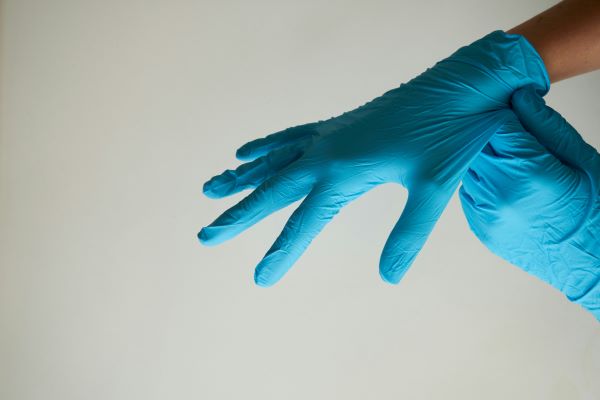
Can you imagine handling bloody body parts with your bare hands? No gloves. No personal protection equipment.
That used to be the norm! As a writer, I work hard to make my stories as accurate as possible. But Technology and crime investigation procedures are always changing. This can create an extra layer of difficulty for writers of historical fiction crime stories.
I recently ran into this challenge as I wrote a scene for my next Neil Gatlin thriller, Rescuing the Invisible.
In my scene, Neil is examining some newspaper articles for clues. These articles are also evidence the police will need to catch and prosecute the vile group of human traffickers Neil is chasing.
Rescuing the Invisible takes place in 1976. As I was writing this scene, I thought, “Neil should be careful not to get his prints on these articles, or destroy any prints already there. He should wear gloves.”
But that got me wondering,
“When did police investigators start wearing protective equipment?”
The research surprised me.
Rubber gloves have been around for longer than you might have realized. A man named William Stewart Halsted originally invented them in 1894 to protect his wife Caroline Hampton’s hands from the chemicals used in daily surgeries.
That said, police didn’t start using rubber gloves until 1924. What took so long? Believe it or not, it started in with a baggage claim ticket for the Waterloo train station that led to a grisly crime scene in a Sussex bungalow.
In April 1924, the wife of Patrick Mahon, was suspicious about her husband’s odd behavior. When she discovered a baggage claim ticket in her husband’s suit pocket, she asked her friend, a former police officer, to check it out.
The former police officer retrieved the bag from the Waterloo train station. He pried open the locked bag enough to see a knife and bloodied undergarments. He notified police, who according to some accounts tested a piece of the fabric and determined it contained human blood. The former officer then returned the bag to the train station and asked Mahon’s wife to place the ticket back in her husband’s suit pocket.
Police then watched the train station, and once Mahon had collected the bag and was leaving the station, they arrested him. Detective Chief Inspector Percy Savage questioned Mahon with the unopened bag on the table. Once he admitted the bag was his, Savage opened it. There were several bloodstained items, including a canvas racket bag with initials “EBK” and torn women’s bloomers, which had been sprinkled with disinfectant.

One wonders if the suspect wore gloves.
Mahon’s explanation was “I suppose I have carried home meat for dogs in it.”
“That explanation won’t do,” said Savage, and so the two sat in silence for fifteen minutes.
“I wonder if you can realize how terrible a thing it is for somebody’s body to be active and one’s mind to fail to act,” said Mahon.
Savage said nothing, and the two sat for another thirty minutes until Mahon said, “I’m considering my position.”
Again, Savage did not respond, but let Mahon’s thoughts and fears get the best of him. After another fifteen minutes of silence, Mahon said, “I suppose you know everything. I’ll tell you the truth.”
Patrick Mahon then told a story of how he and his mistress, Ms. Emily Beilby Kaye, had an argument, and that she had thrown an axe at him, hitting a door frame. He said that they had a struggle, and she had fallen, and hit her head on the coal-scuttle and died. He claimed he was afraid of being charged with murder, so he dismembered her body.
Constable Frederick and DCI Savage traveled to the cottage on the Sussex coast between Eastbourne and Pevensey Bay, known as the Crumbles. Upon entering, they found body parts everywhere. Mahon had placed Emily Kaye’s torso in the trunk in a bedroom that he later screwed the door shut when he had another woman in the cottage. They found other body parts in a hatbox and a biscuit tin. In addition, they discovered pieces of boiled flesh in a saucepan, and bone fragments in the ashes of the fire.
Medical examiner in horror over lack of personal protection equipment.
British pathologist, Sir Bernard Spilsbury, was called in as the chief medical examiner. When he arrived at the scene, he observed to his horror that officers were picking up body parts with their bare hands and placing them in buckets.
When Spilsbury asked Savage why they weren’t wearing rubber gloves, the detective explained that they never wore gloves.
Spilsbury noted that there was no damage to either the doorframe or the coal-scuttle. In fact, there was no blood or hair on the coal-scuttle. He determined that even if she had banged her head on it, the coal-scuttle was too flimsy to have killed her. He also collected all available body parts to piece Emily back together. And though her uterus was missing, the examination of Emily Kaye’s breasts showed she was pregnant. This presented a motive for Mahon to commit murder.
With Mahon’s testimony that Emily Kaye had died from a head injury, Spilsbury needed her head to examine. But detectives never found Emily’s head. Mahon admitted to boiling the head and then burning it in the fire. To determine if this was feasible, Spilsbury did the same with a goat’s head. He discovered it was possible to turn the head into something brittle enough to smash into pieces.
When police followed up on Mahon’s testimony that he purchased a 10” butcher knife and a meat saw, they discovered that his purchase was made before Emily Kaye’s death, not after, establishing that the murder was premeditated.
A change to personal protective equipment.
Mahon was convicted of murder and executed by hanging at Wandsworth Prison on September 2, 1924.
That detectives were handling body parts without protection concerned Sir Spilsbury a great deal. He reported his concern to Detective Superintendent William Brown, who was the head of the murder squad. Brown suggested they create a standardized kit for officers in the field.
This kit become known as the “Murder Bag” and contained rubber gloves, a tape measure, a straightedge ruler, magnifying glass, swabs, bags for samples, forceps, scissors, scalpel, and other instruments that might be needed.
Copyright 2023 Ida Smith. No part of this may be sold or copied without express permission from the author.
Note from the Author
In researching this horrible story, I ran across what appeared to me to be conflicting information. I found two different names for Patrick Mahon’s wife, so I just called her his wife. Some resources said that the wife’s friend, who investigated the claim ticket was a former police officer. Another said he was a former railway police officer, and another said he was a private investigator. I stuck with a former police officer as he knew what to do.
There was reference to the bag found at the train station being a “Gladstone.” One source said the trunk with the torso in it was a Gladstone and another source said that Mahon had tossed a Gladstone containing body parts from the train. It’s possible there was more than one Gladstone bag, as they were popular. But that Mahon used a Gladstone to dispose of some of the body parts contradicts another source that said officers searched the rail line but found no body parts.
All this to say, that I’ve done my best to present the facts as I see them. I only alluded to Patrick Mahon’s womanizing. I didn’t mention his other character faults, including embezzlement or a bank raid—again, depending upon which source you look at. The important thing is that he was caught and forensics played a part in that.
Resources: (Listed in alphabetical order.)
- History.com “This Day In History: May | 2 1924 A grisly murder makes rubber gloves standard equipment at crime scenes” History.com Editors, November 13, 2009 <https://www.history.com/this-day-in-history/a-grisly-crime-leads-to-rubber-gloves> (Accessed 9-11-23)
- Mental Floss “Why Police Started Wearing Goves at Crime Scenes” Stacy Conradt, May 2, 2017 <https://www.mentalfloss.com/article/500503/why-police-started-wearing-gloves-crime-scenes> ( Accessed 3, September 2023).
- Murderpedia “Patrick Herbert MAHON” <http://murderpedia.org/male.M/m/mahon-patrick.htm> (Accessed 9-11-23)
- Psychology Today “The Murder Squad: Need and error inspired early crime scene innovations.” Katherine Ramsland Ph.D. <https://www.psychologytoday.com/intl/blog/shadow-boxing/201411/the-murder-squad> Accessed September 11, 2023).
- Wikipedia “Murder Bag” https://en.wikipedia.org/wiki/Murder_bag (Accessed September 11, 2023)
- Wikipedia “Rubber glove” https://en.wikipedia.org/wiki/Rubber_glove (Accessed September 11, 2023)